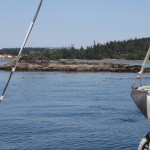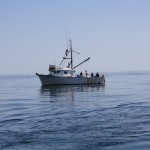7/25/09
David Howitt and Jason deployed hydrophone 2 and 1 in the North array today at around 2:00 pm. We moved the last two tires into place and placed another tire at the end of the cable protector to hold it in place. During the dive we resurveyed the original placements so that we had measurements from a single dive. The data collected are as follows:
Each tire is ~ 8 meters apart
Bearing along coast line: 330 degrees
#4 hydrophone 30 feet depth.
Bearing from #4 to #3 is 280 degrees
#3 hydrophone 35 feet depth.
Bearing from #3 to #2 is 250 degrees
#2 hydrophone 44 feet depth.
Bearing from #2 to #1 is 220 degrees.
#1 hydrophone 57 feet depth.
Read More
On 6/27/09 Val and Jason deployed another Vemco fish receiver at the mouth of False Bay in a depth of 26 feet at 14:22 (should have been ~ 0.16 tide at the time). The location was 48 degrees 28.748 N and 123 degrees 04.411. This location is just off the small island in the mouth of the bay. The serial number of the unit is 100910.
While we were there, a boat with a banner reading ‘Fish Research’ was also present. In talking to them, they told us they were in the process of removing old derelict fishing gear. The name of the vessel was Bet-Sea and had the numbers 785 and 53661 on it. We also spotted this same vessel off False Bay during the Spring 09 quarter.
Read More
Mitchell Bay to Griffin Bay
After a hearty breakfast of chocolate chip pancakes thanks to Hilary we had an early start from Mitchell Bay out into Haro Strait.
As we headed south in Haro Strait we ended up with a decent breeze from the SE which we took advantage of for some nice sailing.
We practiced tacks, chicken jibes and a hove to. The hove to was performed in between Discovery Island and Beaumont Shoals, the area we thought was the potential source of the mysterious clanging on the hydrophones at Lime Kiln and Orca Sound. Although we listened for 15 minutes we heard no clanging, but did hear the numerous container ships passing by. There was not a lot of wind and we were at slack low tide, so it may not have been the appropriate conditions needed to generate the mysterious clanging.
The breeze died down in the afternoon, but we did manage to ride what wind was available and the currents towards the south end of San Juan Island and into Cattle Pass.
We got to experience Cattle Pass on a raging flood. As we were sucked north by the current we managed to see 16 Stellar sea lions hauled out on Whale Rocks as well as cormorant nests on Goose Island.
Rounding the bend Captain Mike showed us how to anchor off the shore of American Camp in Griffin Bay where we worked on our localization exercise using the software Ishmael.
Altogether a sunny, breezey and pleasant day.
JW
Read More
Prevost Harbor to Mitchell Bay
At 09:30 hours Val did a lecture on localization. Right after the lecture we did an exercise on localization involving the ‘clangs’ at the OrcaSound and Lime Kiln hydorphone’s (there are some msyterious clanging/clinking sounds that have been heard intermitently on the hydrophones this winter/spring). Our results indicated that the hyperbola leads to Discovery Island / Beaumont Shoals. This is just an estimate from where the sound source may be.
Then at 13:25 hours we had an encounter with three transients whales. We have IDed them as T10,T10B, and T10C. We first saw them at Mandarte Is. and they were traveling northwest. Then at 1400 hours they switched direction and started heading north towards Stuart Island. Then entire time they were traveling. We also found traces of whale poo! It was another interesting encounter with the Transients. It was a surprise encounter as well because they just popped out of the water and shocked us all! Finally at 16:20 hours we did the localization exercise with the array and our sound source on the dinghy. The position of the exercise was at N 98 degrees 34.902 W 23 degrees 11.881.
The data was uploaded to the Beam Reach computer and will be analyzed at a later date.
PV
Read More
During this first week of our time aboard the Gato Verde we have been getting accustomed to life aboard, running the boat systems and working with our research methods and equipment. As part of doing our research we are getting in the habit of taking notes about where we have been and what we have done so that we have a log to go back to in the future as we start analyzing our data. In order to have a backup of that data and to share our daily experiences with you, we have been posting those science logs as blogs. To make it easier I have been uploading them as we have internet connection, but the reality is that we have all been taking turns writing the science log. So although it shows my name on the blog, in reality it is usually one of the students who have written the daily log. So that you know who wrote each log we will put their initials at the end of the blog.
We hope you enjoy following along with the research experience!
Read More
Snug Harbor to Snug Harbor
There was a heavy fog all morning. Students went over data sheets and thought about how easy it would be to run statistical tests on data collected and how easy it would be to turn into an excel spreadsheet.
We also made a list of science goals. Analyzing our data sheets were at the top of the list followed by behavior recognition improvement, ID the whales from yesterday, practice hydrophone deployment, read the journal article for journal club and possibly deploy the Vemco acoustic tag receiver.
At around noon the fog finally cleared out and we had a quick lesson on sailing and how the boat moves using the wind and then we went out to practice.
After sailing in about 20 knot winds for an hour or two we came back to Mitchell Bay. We continued our sailing lesson and went over terminology and ended the day with learning how to tie knots.
In the evening we read the journal article for our journal club discussion and tried to identify the transients we saw yesterday. We positively identified T40 but could only identify one female, T37b.
We need an updated transient ID guide because the guide only has photos of the left side of the saddle patch and most of our pictures were of the right side.
EB
Read More
Jones Island to whales to Snug Harbor
Students raised the main sail for the first time on the Green Gato, and we sailed slowly from Jones Island to the beginning of Spieden channel. There the wind died, so we started motoring to Roche Harbor, where Val sped off to shore in the dinghy. We continued motoring towards Mitchell Bay and caught the wind for a while. When Todd noticed a little cluster of whale watching boats in Canada, we motored over to check it out. There they were — orcas — on the first full day at sea! Wahoo!
The whales we encountered were transients (the male T40 with four females) and they were frolicking and porpoising with glee. We stayed with them for about an hour, recording behavior and boat numbers. They started traveling north and we lost ’em. We motored back to Mitchell Bay, deploying the hydrophone as a demo on the way. We moored in the sunshine for an evening of swimming, burritos, and Grimm fairytales. -hmm.
Read More
58837
FHL to Jones Island
OK, we didn’t discover giant squid, but the students did get a chance at the helm of the Gato Verde. The students were very efficient in moving all of the gear and food out of S1 and onto the Gato Verde so that we made a good start from FHL. We even got a chance to see Anne Harmon one of our students from 2007 on the dock at FHL. She is now working for Kwiaht, the Center for Historical Ecology of the Salish Sea. The journey was a smooth one under partly cloudy skies. Transited under electric power and tied up easily to the mooring bouy on the south end of Jones.
Read More
We are off to a great start of classes for the quarter after a harowing ferry crossing to the islands. This morning we even had snow! We can’t wait for the cold plunge in 3 weeks when we get to feel how cold things can be here.
Read More
Today we focused on fishing for the opening day of lingcod season. Everyone caught at least one fish, with several lingcod (too small for tagging unfortunately), and a few quill back rockfish. Laura caught the first taggable fish, a 26 inch lingcod. The surgery was performed after a few second dip in clove oil water anesthetized the fish. A small lateral incision was made in the ventral side of the fish and the tag was inserted. The incision was stitched up delicately and the patient seemed to be doing well upon release. We spent the whole afternoon fishing around Limekiln with our fish expert Eric and naturalist friend Erin and Jason in Eric’s motorboat for the second lingcod big enough to tag, but we were unsuccessful and had to quit around 5pm.
Read More






 Twitter
Twitter LinkedIn
LinkedIn Facebook
Facebook